42 Years Of The Honda Interceptor
What's in a name?
Straight from the source, Jon Row, a retired 35-year veteran of American Honda. Here's what he had to say on the subject in a letter to the editor of Rider magazine:
"Honda's long-time aeronautic interests are obvious, and fighter plane influences were well documented, beginning with the 1978 CBX. The Interceptor name, however, didn't originally have an aeronautic basis. I was responsible for most of American Honda's motorcycle naming in the early to mid-80s including, among others, Sabre, Magna, Interstate and Nighthawk. The Interceptor moniker (and V45 series' use of cubic-inch reference) was based on admiration of 1950's and '60's police car engines and their 'street cred.' Ironically, 'Interceptor' was intended to be used on another model in 1982 but, fortunately, was held back and utilized for the iconic 1983 VF750F, which now seems only natural."
Straight from the source, Jon Row, a retired 35-year veteran of American Honda. Here's what he had to say on the subject in a letter to the editor of Rider magazine:
"Honda's long-time aeronautic interests are obvious, and fighter plane influences were well documented, beginning with the 1978 CBX. The Interceptor name, however, didn't originally have an aeronautic basis. I was responsible for most of American Honda's motorcycle naming in the early to mid-80s including, among others, Sabre, Magna, Interstate and Nighthawk. The Interceptor moniker (and V45 series' use of cubic-inch reference) was based on admiration of 1950's and '60's police car engines and their 'street cred.' Ironically, 'Interceptor' was intended to be used on another model in 1982 but, fortunately, was held back and utilized for the iconic 1983 VF750F, which now seems only natural."
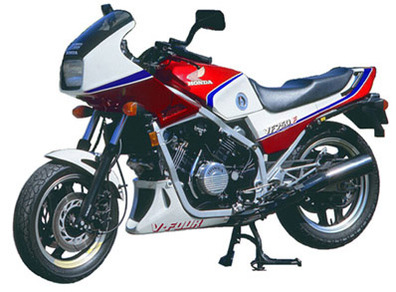
Where do we start?
Honda Motor Company Ltd. was undeniably on a roll in the 1970's. After virtually inventing the modern motorcycle via the 1969 CB750, Honda helped to fuel a huge resurgence of the sport throughout the 70's, forcing everyone else to play catch-up. Never one to take a back seat, Soichiro Honda knew that to stay on top would take bold new directions, and late in the decade innovative surprises like the CX500 and six-cylinder CBX sent everyone back to the drawing board. Our story begins in 1982....
Gen 1 1983-85
Seemingly always a step or two ahead, Mr. Honda was already off in yet another new direction. In the summer of 1981 a group of moto journalists gathered at the company's request were knocked off their stools by the unveiling of the 1982 V4 powered V45 (750cc) Magna and Sabre. Next up was the debut of the V45 Interceptor in early 1983 and the sport bike riders had their day. Honda put buckets of money into the V4 concept, expecting it to be the new standard on both street and track. In racing, the AMA lowered the popular Superbike class displacement limit to 750cc and required the base chassis to be essentially stock. This was Honda's target, and culminated in a 1985 Daytona 200 win with Freddie Spencer aboard. In his words, "Honda had built a bike to race first and be a streetbike second." Fact: Spencer never lost a race aboard the Interceptor in the '83 and '84 seasons.
Streetwise, the VF750F was an instant winner, the magazines of the day spewing forth its praises. Cycle magazine's first full road test of the '83 Interceptor ran for nine pages, with a technical dissertation that took another nine. "There's nothing like perfect teamwork...(and) the Interceptor is this kind of partner. As a sport bike it's nearly perfect...." Underscoring its historical significance, an '83 VF750 Interceptor was one of the featured models in the 1998 Art of the Motorcycle exhibition at New York's Guggenheim Museum.
The company went headlong into the V4 concept, generating a full line of cruiser, muscle and sport models in only three year's time:
V30 Magna (500cc)
VF500 Interceptor (derived from the Japan & Euro-market VF400)
V45 Magna & Sabre (in both 750cc and tariff-busting 700cc displacements)
V45 Interceptor (700/750)
V65 Magna & Sabre (1100cc)
VF1000F Interceptor
VF1000R
Honda Motor Company Ltd. was undeniably on a roll in the 1970's. After virtually inventing the modern motorcycle via the 1969 CB750, Honda helped to fuel a huge resurgence of the sport throughout the 70's, forcing everyone else to play catch-up. Never one to take a back seat, Soichiro Honda knew that to stay on top would take bold new directions, and late in the decade innovative surprises like the CX500 and six-cylinder CBX sent everyone back to the drawing board. Our story begins in 1982....
Gen 1 1983-85
Seemingly always a step or two ahead, Mr. Honda was already off in yet another new direction. In the summer of 1981 a group of moto journalists gathered at the company's request were knocked off their stools by the unveiling of the 1982 V4 powered V45 (750cc) Magna and Sabre. Next up was the debut of the V45 Interceptor in early 1983 and the sport bike riders had their day. Honda put buckets of money into the V4 concept, expecting it to be the new standard on both street and track. In racing, the AMA lowered the popular Superbike class displacement limit to 750cc and required the base chassis to be essentially stock. This was Honda's target, and culminated in a 1985 Daytona 200 win with Freddie Spencer aboard. In his words, "Honda had built a bike to race first and be a streetbike second." Fact: Spencer never lost a race aboard the Interceptor in the '83 and '84 seasons.
Streetwise, the VF750F was an instant winner, the magazines of the day spewing forth its praises. Cycle magazine's first full road test of the '83 Interceptor ran for nine pages, with a technical dissertation that took another nine. "There's nothing like perfect teamwork...(and) the Interceptor is this kind of partner. As a sport bike it's nearly perfect...." Underscoring its historical significance, an '83 VF750 Interceptor was one of the featured models in the 1998 Art of the Motorcycle exhibition at New York's Guggenheim Museum.
The company went headlong into the V4 concept, generating a full line of cruiser, muscle and sport models in only three year's time:
V30 Magna (500cc)
VF500 Interceptor (derived from the Japan & Euro-market VF400)
V45 Magna & Sabre (in both 750cc and tariff-busting 700cc displacements)
V45 Interceptor (700/750)
V65 Magna & Sabre (1100cc)
VF1000F Interceptor
VF1000R
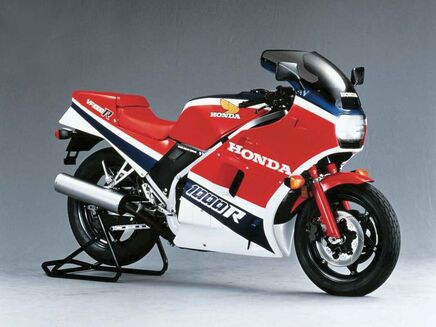
There being no American racing class for the 500 and 1000cc models, Honda naturally emphasized the VF750 in this country – "Win on Sunday, sell on Monday." Honda's short and unsuccessful production stint with the big-bore VF1000 resulted in two distinct models for the U.S. market. 1984 saw the introduction of the "F" Interceptor model which was essentially a larger version of the VF750F. With flaccid sales the Euro "R" version quickly replaced the F in 1985. The frame and rear shock were carryovers but the rest of the VF1000R was a thorough redesign, employing gear-driven cams, full bodywork and different wheels, brakes and more. Styling was meant to mimic the endurance racer look popular in Europe. The big VF continued in the U.S. through 1986 with some minor changes, the most obvious being cosmetics; minor paint scheme changes and dual-bulb headlights replacing the squarish one from '85 (and the Interceptor name dropped). While the R model was a technological and aesthetic improvement over the F, it was also heavier and more expensive...and slower than the inline-four competition, even Honda's own 1000 Hurricane. In the end, it was all a case of bad timing. Trounced by Kawasaki's new water-cooled Ninja 900, the 1000 left the showroom in '86, along with the big Magna and VF500. Meantime, the V30 Magna and both Sabres departed in 1985.
Some of the model attrition was the result of serious teething problems with the new models, a major faux pas on the part of a manufacturer with its reputation built on precision engineering. Turns out some early V4's suffered from camshaft oiling problems and the 500 from spun crankshaft bearings. Honda spent millions on damage control but the entire V4 concept suffered in customers' perceptions. Soichiro insisted on the project going forward, however, and the result was an entirely new model.
Some of the model attrition was the result of serious teething problems with the new models, a major faux pas on the part of a manufacturer with its reputation built on precision engineering. Turns out some early V4's suffered from camshaft oiling problems and the 500 from spun crankshaft bearings. Honda spent millions on damage control but the entire V4 concept suffered in customers' perceptions. Soichiro insisted on the project going forward, however, and the result was an entirely new model.
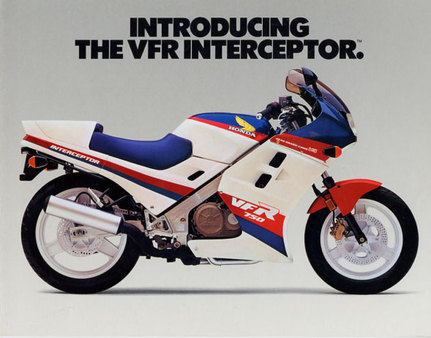
Gen 2 1986-87
This was a clean-sheet design, beginning with the model designator; the VF became the VFR. The bike lost 40+ pounds and gained somewhere between five and 22 horsepower, depending upon who you wished to believe. A gorgeous full fairing appeared along with a lightweight aluminum twin-spar frame and air-adjustable fork. The engine was all new, now with a 180-degree crankshaft as opposed to the previous 360, the cam drive employing a very racy and complex gear drive, a sixth gear added, the RPM up to 11000. Still sporting a 16-inch front wheel and bias-ply tires, the VFR came in a striking white with red & blue accents, or pearl white with gold lettering, or the somewhat rare dark blue with grey accents. For 1986 the engine was available as a 700cc (RC26) or 750 (RC24), with at least twice the number of 700's produced over the 750 version. Only the 700cc was available in '87, making the VFR750F a one-year model. A slightly upgraded F2 700cc model appeared in mid-'86, major differences being square instruments design, shortened shifter, fully digital ignition, revised fork and shock damping and some internal engine tweaks.
The VFR was an improvement over the VF in every subjective and objective measurement. The bad juju from the VF's "troubles" were forgotten, the press gushed (again), discerning riders paid Honda's price premium, and heavily modified factory racers took the AMA Superbike championship in '87 and '88 and even the new World Superbike championship in '88 and '89 on what was actually the factory race bike version known as the RC30.
And then they vanished, at least in the U.S. market. The only remaining "Interceptor" for the decade was the little VTR250. The last American-market V4 was the 1988 V45 Magna, though the VFR continued in production in Europe, where the sport touring concept was firmly established. What happened? Honda was most likely shooting itself in the foot by pitting the V4 against its own new inline four-cylinder sport bikes, the 600 and 1000 Hurricanes, and Suzuki's GSX-R750 was quickly rising to the top of the sport bike heap. It was time to redefine the V4's, or, more precisely, the VFR's niche.
This was a clean-sheet design, beginning with the model designator; the VF became the VFR. The bike lost 40+ pounds and gained somewhere between five and 22 horsepower, depending upon who you wished to believe. A gorgeous full fairing appeared along with a lightweight aluminum twin-spar frame and air-adjustable fork. The engine was all new, now with a 180-degree crankshaft as opposed to the previous 360, the cam drive employing a very racy and complex gear drive, a sixth gear added, the RPM up to 11000. Still sporting a 16-inch front wheel and bias-ply tires, the VFR came in a striking white with red & blue accents, or pearl white with gold lettering, or the somewhat rare dark blue with grey accents. For 1986 the engine was available as a 700cc (RC26) or 750 (RC24), with at least twice the number of 700's produced over the 750 version. Only the 700cc was available in '87, making the VFR750F a one-year model. A slightly upgraded F2 700cc model appeared in mid-'86, major differences being square instruments design, shortened shifter, fully digital ignition, revised fork and shock damping and some internal engine tweaks.
The VFR was an improvement over the VF in every subjective and objective measurement. The bad juju from the VF's "troubles" were forgotten, the press gushed (again), discerning riders paid Honda's price premium, and heavily modified factory racers took the AMA Superbike championship in '87 and '88 and even the new World Superbike championship in '88 and '89 on what was actually the factory race bike version known as the RC30.
And then they vanished, at least in the U.S. market. The only remaining "Interceptor" for the decade was the little VTR250. The last American-market V4 was the 1988 V45 Magna, though the VFR continued in production in Europe, where the sport touring concept was firmly established. What happened? Honda was most likely shooting itself in the foot by pitting the V4 against its own new inline four-cylinder sport bikes, the 600 and 1000 Hurricanes, and Suzuki's GSX-R750 was quickly rising to the top of the sport bike heap. It was time to redefine the V4's, or, more precisely, the VFR's niche.
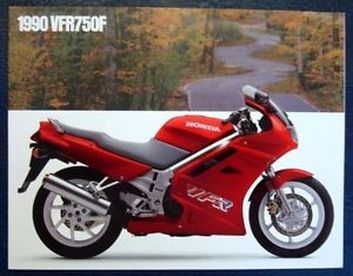
Gen 3 & 4 1990-97
Rather unexpectedly, in late 1989, not one but three all-new V4 models were announced. America already knew of the race-homogation RC30 (see below) and joining it was a street version designated simply as the VFR750F (RC36), dropping the Interceptor name. Alongside these appeared a new, larger road bike with an 1100cc V4 powerplant known as the ST1100, which would define an entirely new model segment – large, comfortable, mile-eating sport touring bikes...but that's another story.
This new VFR borrowed on the RC30 technology, but the two bikes shared not much more than bore & stroke numbers. Some of the new tech included a single-sided swingarm (Pro-Arm), new frame, beefier 41mm cartridge fork, reworked heads, bigger carbs, engine placement lower and forward, and 17-inch wheels with fatter tires and, eventually, radial tires fitted. All good stuff, with the exception of the 40-pound weight gain to 523 pounds (wet). But the model's mission had changed, and was now positioned as a sophisticated Gentleman's Express, if you will. As Motorcyclist magazine observed, "...American Honda knows VFR buyers. They're older, better educated, and clearly more affluent than typical (CBR600) F2 customers." And in its new role the VFR shined. It would win 12 Cycle World Ten Best Awards and represent the benchmark "all-around motorcycle" worldwide. The term "user friendly" had come into use and perfectly described this machine; its combination of power, brakes, handling, comfort and sophistication afforded proud owners one motorcycle that could do just about everything well.
Rather unexpectedly, in late 1989, not one but three all-new V4 models were announced. America already knew of the race-homogation RC30 (see below) and joining it was a street version designated simply as the VFR750F (RC36), dropping the Interceptor name. Alongside these appeared a new, larger road bike with an 1100cc V4 powerplant known as the ST1100, which would define an entirely new model segment – large, comfortable, mile-eating sport touring bikes...but that's another story.
This new VFR borrowed on the RC30 technology, but the two bikes shared not much more than bore & stroke numbers. Some of the new tech included a single-sided swingarm (Pro-Arm), new frame, beefier 41mm cartridge fork, reworked heads, bigger carbs, engine placement lower and forward, and 17-inch wheels with fatter tires and, eventually, radial tires fitted. All good stuff, with the exception of the 40-pound weight gain to 523 pounds (wet). But the model's mission had changed, and was now positioned as a sophisticated Gentleman's Express, if you will. As Motorcyclist magazine observed, "...American Honda knows VFR buyers. They're older, better educated, and clearly more affluent than typical (CBR600) F2 customers." And in its new role the VFR shined. It would win 12 Cycle World Ten Best Awards and represent the benchmark "all-around motorcycle" worldwide. The term "user friendly" had come into use and perfectly described this machine; its combination of power, brakes, handling, comfort and sophistication afforded proud owners one motorcycle that could do just about everything well.
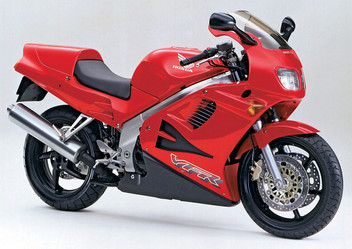
For 1994 (Gen 4) some upgrades were made. Beyond styling changes (with influence from the NR, see below), the bike lost 20 pounds, gained semi-flat slide carbs (same smaller size as the '86), new cams and a few more horses. Devotees often argue that this final iteration of the VF/VFR remains the best of the 700/750cc series, even to this day.
I should note for the record that the V45 Magna reappeared in 1994 and would remain in the lineup through 2003.
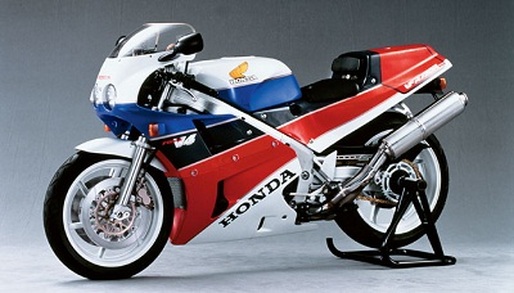
RC30 (VFR750R) 1990 (U.S.)
Ah, the mystical, mythical RC30; just uttering those alphanumerics will hush a room of VFR-isti. What's so special?
Introduced for the 1988 model year in Europe, the "R" would be Honda's homologation machine for the new 750cc World Superbike Championship that would begin that year. As such, it was a limited production model, and was genuinely a factory race bike (based heavily on the RVF racers) with street-legal hardware added — even the rear sprocket was safety-wired from the factory. Surprisingly, it only made about 10 horsepower more than the '86 VFR "F" street bike, but is 75 pounds lighter and bristled with factory bits like titanium con rods and an oil cooler which itself was cooled by engine coolant. Lovingly hand assembled, fit & finish of a quality timepiece, and as gorgeous today as ever. It trounced the racing competition, and the few that survived the racing life or were coveted as street-only bikes command longing stares and big money today, and deservedly so.
Honda even produced a zen-like video of the engine assembly:
Ah, the mystical, mythical RC30; just uttering those alphanumerics will hush a room of VFR-isti. What's so special?
Introduced for the 1988 model year in Europe, the "R" would be Honda's homologation machine for the new 750cc World Superbike Championship that would begin that year. As such, it was a limited production model, and was genuinely a factory race bike (based heavily on the RVF racers) with street-legal hardware added — even the rear sprocket was safety-wired from the factory. Surprisingly, it only made about 10 horsepower more than the '86 VFR "F" street bike, but is 75 pounds lighter and bristled with factory bits like titanium con rods and an oil cooler which itself was cooled by engine coolant. Lovingly hand assembled, fit & finish of a quality timepiece, and as gorgeous today as ever. It trounced the racing competition, and the few that survived the racing life or were coveted as street-only bikes command longing stares and big money today, and deservedly so.
Honda even produced a zen-like video of the engine assembly:
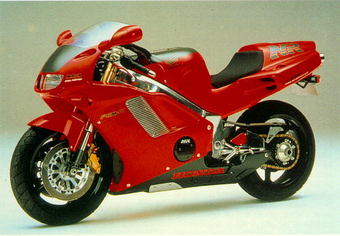
NR (NR750) 1992
This bit of super-exotica never officially made it to these shores from a production run of about 700 worldwide. Based upon the oval-piston V4 500cc GP racer of 1979 it evolved into the NR750 endurance race bike during the 80's. The concept behind the oval piston design is simply to make room for better breathing via eight valves per cylinder, resulting in more power. A very short 42mm stroke allowed a 14,000 redline, and the factory claimed 125 horsepower from the 750. The original NR500 was really just a sly way to build a V8 engine while complying with rules limiting engines to four combustion chambers. Kudos to Honda for stretching the envelope on this one, but sadly the whole thing never really came together. As if to salvage a bit of the ocean of yen it took to develop the bike, Honda offered the road-going NR in 1992 at $50,000 each, by far the most expensive road bike available at the time.
Here's a link to a VisorDown.com article on the Ten Things That Made The Honda NR Ahead Of Its Time.
This bit of super-exotica never officially made it to these shores from a production run of about 700 worldwide. Based upon the oval-piston V4 500cc GP racer of 1979 it evolved into the NR750 endurance race bike during the 80's. The concept behind the oval piston design is simply to make room for better breathing via eight valves per cylinder, resulting in more power. A very short 42mm stroke allowed a 14,000 redline, and the factory claimed 125 horsepower from the 750. The original NR500 was really just a sly way to build a V8 engine while complying with rules limiting engines to four combustion chambers. Kudos to Honda for stretching the envelope on this one, but sadly the whole thing never really came together. As if to salvage a bit of the ocean of yen it took to develop the bike, Honda offered the road-going NR in 1992 at $50,000 each, by far the most expensive road bike available at the time.
Here's a link to a VisorDown.com article on the Ten Things That Made The Honda NR Ahead Of Its Time.
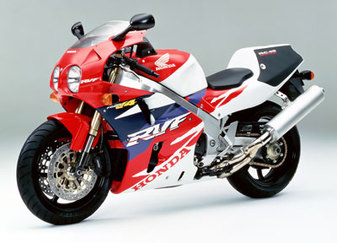
RC45 (RVF750R) 1994
The successor to the RC30, this homologation special was actually built from 1994-99, but available in the U.S. for the first year only. Borrowing much from both the RC30 and NR750, the fuel-injected RC45 eventually garnered many wins for Honda from '95-98. Only 200 were manufactured worldwide and, per AMA rules, 50 imported to the U.S. with about 20 going to private race teams. It is one of the rarest Hondas and some consider it the best Superbike ever (source: Wikipedia). The U.S. street version made 105 HP, the Euro version 118 and the race bikes up to 190.
The successor to the RC30, this homologation special was actually built from 1994-99, but available in the U.S. for the first year only. Borrowing much from both the RC30 and NR750, the fuel-injected RC45 eventually garnered many wins for Honda from '95-98. Only 200 were manufactured worldwide and, per AMA rules, 50 imported to the U.S. with about 20 going to private race teams. It is one of the rarest Hondas and some consider it the best Superbike ever (source: Wikipedia). The U.S. street version made 105 HP, the Euro version 118 and the race bikes up to 190.
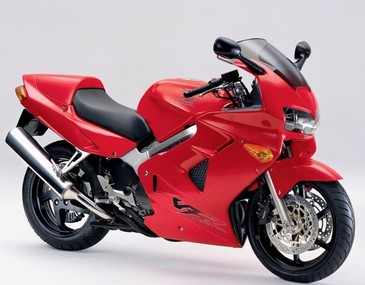
Gen 5 (VFR800) 1998-2001
Staying with the company's four-year model cycle, Honda introduced an all-new platform in '98, one that remained true to the basic Interceptor formula but with updated style and splashes of hi-tech. And, notably, the Interceptor name returned.
With a nod to the RC45, the V4 mill was substantially reworked; the bore & stroke numbers of 70 x 48.4mm, around since the beginning, were nudged to 72 x 48mm for a total of 781cc. The designator would now be VFR800FI, the final letter representing fuel injection. The EFI would eventually require a catalytic converter and O2 sensor. The cam gears were moved to the right side of the engine and compression bumped from 11:1 to 11.6:1. The engine was a few pounds lighter, a bit narrower, a few more ponies (108 HP claimed) and redline bumped to 11,750 RPM. But out on the twisties, the 800 proved no quicker than the 750 it replaced.
A new chassis was in order; lighter, stiffer, with a shortened wheelbase and steeper rake. The excellent Pro-Arm single-sided swingarm remained, but it and the shock now pivoted directly from the engine cases, something Honda dubbed "Tuned Flex." Brakes were in for a major upgrade; a dual linked braking system, DCBS, wherein both the front and rear levers actuated portions of the others' calipers. It was techie, it was cool and it worked, Rider magazine calling the system "world class."
This model was fresh take on the VFR concept, transforming it into a new-millinium motorcycle. Motorcyclist wrote in 1998, "This year (it) has no equal in all of motorcycling. It is not the fastest or the lightest or the quickest. It is simply the best. And in an age where there are no bad motorcycles, that's saying a mouthful."
Staying with the company's four-year model cycle, Honda introduced an all-new platform in '98, one that remained true to the basic Interceptor formula but with updated style and splashes of hi-tech. And, notably, the Interceptor name returned.
With a nod to the RC45, the V4 mill was substantially reworked; the bore & stroke numbers of 70 x 48.4mm, around since the beginning, were nudged to 72 x 48mm for a total of 781cc. The designator would now be VFR800FI, the final letter representing fuel injection. The EFI would eventually require a catalytic converter and O2 sensor. The cam gears were moved to the right side of the engine and compression bumped from 11:1 to 11.6:1. The engine was a few pounds lighter, a bit narrower, a few more ponies (108 HP claimed) and redline bumped to 11,750 RPM. But out on the twisties, the 800 proved no quicker than the 750 it replaced.
A new chassis was in order; lighter, stiffer, with a shortened wheelbase and steeper rake. The excellent Pro-Arm single-sided swingarm remained, but it and the shock now pivoted directly from the engine cases, something Honda dubbed "Tuned Flex." Brakes were in for a major upgrade; a dual linked braking system, DCBS, wherein both the front and rear levers actuated portions of the others' calipers. It was techie, it was cool and it worked, Rider magazine calling the system "world class."
This model was fresh take on the VFR concept, transforming it into a new-millinium motorcycle. Motorcyclist wrote in 1998, "This year (it) has no equal in all of motorcycling. It is not the fastest or the lightest or the quickest. It is simply the best. And in an age where there are no bad motorcycles, that's saying a mouthful."
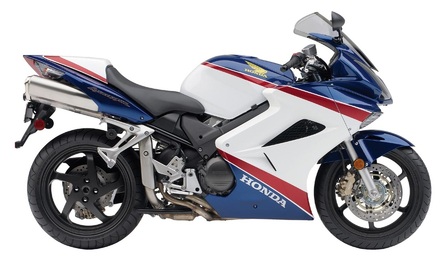
Gen 6 2002-09
In 2002 the sixth generation appeared, distinguishing itself, in part, by the addition of Honda's variable valve actuation technology, VTEC, wherein the engine operated on two valves per cylinder at lower RPM, then actuating the remaining two above 6800 RPM. The idea is sound; torque is improved at lower revs, horsepower is improved at higher revs and emissions are improved. Theory doesn't always transfer seamlessly, however, and in practice the transition point proved to be a bit abrupt. The magazines panned it and owners whined. Honda never would let go of the concept, but in 2006 made a token concession by lowering the VTEC activation to 6400 RPM, but the critics weren't appeased.
Further infuriating the faithful, the sixth gen also lost the sophisticated gear-driven cams, a VFR bragging point since the 1986 re-design. A cam chain took its place, which surely helped manufacturing costs. To its credit this model gained two genuine improvements — optional ABS and optional hard luggage, along with a very chic, but hot and heavy, underseat exhaust. The fairing was redone with more modern, angular lines, and in 2007 a special 25th anniversary color scheme was offered, channeling the second generation red/white/blue look — almost no one liked it.
Despite the naysayers, the VFR800FI Interceptor is still a rider's machine and a worthy successor, continuing the innovative spirit of the V4 Interceptor. Production of the VFR800 continued in other markets, but in 2010 Honda would surprise us all with something completely different.
In 2002 the sixth generation appeared, distinguishing itself, in part, by the addition of Honda's variable valve actuation technology, VTEC, wherein the engine operated on two valves per cylinder at lower RPM, then actuating the remaining two above 6800 RPM. The idea is sound; torque is improved at lower revs, horsepower is improved at higher revs and emissions are improved. Theory doesn't always transfer seamlessly, however, and in practice the transition point proved to be a bit abrupt. The magazines panned it and owners whined. Honda never would let go of the concept, but in 2006 made a token concession by lowering the VTEC activation to 6400 RPM, but the critics weren't appeased.
Further infuriating the faithful, the sixth gen also lost the sophisticated gear-driven cams, a VFR bragging point since the 1986 re-design. A cam chain took its place, which surely helped manufacturing costs. To its credit this model gained two genuine improvements — optional ABS and optional hard luggage, along with a very chic, but hot and heavy, underseat exhaust. The fairing was redone with more modern, angular lines, and in 2007 a special 25th anniversary color scheme was offered, channeling the second generation red/white/blue look — almost no one liked it.
Despite the naysayers, the VFR800FI Interceptor is still a rider's machine and a worthy successor, continuing the innovative spirit of the V4 Interceptor. Production of the VFR800 continued in other markets, but in 2010 Honda would surprise us all with something completely different.
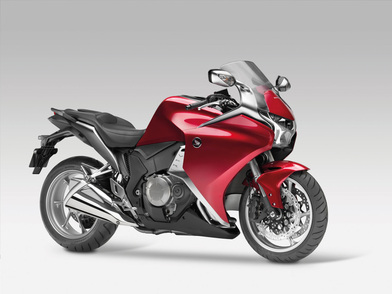
Gen 7 (VFR1200) 2010-13
If ever there was shake-up to an established model, this is it. Under complete secrecy, "unofficial" leaks, teaser web shots and a corporate countdown timer, Honda finally unveiled the new VFR at the '09 Tokyo Motor Show — to raised eyebrows everywhere.
The engine was still a V4, but with MotoGP architecture, SOHC Unicam valve train design from its own motocross bikes, a huge jump out of the VFR's mid-size niche to 1237cc displacement, shaft drive, throttle-by-wire, 613 pounds (!), and the big one, an optional Dual Clutch Transmission (DCT). This was a lot to assimilate and the VFR faithful were understandably skeptical.
A mechanical masterpiece, the engine churns out 150 horsepower and 85 pounds of torque — at the rear wheel! The DCT, the first such system fitted to a motorcycle, allows three distinct rider-selectable modes: fully automatic, "sport" automatic, and manual paddle-shifter. The brakes were the latest from Honda, C-ABS, or combined (linked) ABS where the front/rear proportioning is electronically controlled. The bodywork also borrows from the MotoGP race bike, designed to pull heat away from the rider and aid high-speed and turning stability. The fit & finish are second to none and set a new quality standard industry-wide. Despite its weight, the bike flows down the road and it needs to make no apologies for handling prowess. A true sport tourer of the highest order. Well... there's the fuel mileage. The five-gallon tank will run dry a bit shy of 200 miles, not the best situation for a high-speed, long-legged motorcycle.
In 2012 a mild update included refinements to the DCT, traction control was added and a new seat fitted. 2013 was to be the 1200's final year in the U.S. market.
It was all a bit much. Reviewers never warmed up to this VFR (though it earned Rider magazine's 2010 Motorcycle of the Year) and buyers couldn't figure out where this $16,000 moto fit in the scheme of things. Sales went south...and stayed there. On to Plan B...or was it back to the future?
If ever there was shake-up to an established model, this is it. Under complete secrecy, "unofficial" leaks, teaser web shots and a corporate countdown timer, Honda finally unveiled the new VFR at the '09 Tokyo Motor Show — to raised eyebrows everywhere.
The engine was still a V4, but with MotoGP architecture, SOHC Unicam valve train design from its own motocross bikes, a huge jump out of the VFR's mid-size niche to 1237cc displacement, shaft drive, throttle-by-wire, 613 pounds (!), and the big one, an optional Dual Clutch Transmission (DCT). This was a lot to assimilate and the VFR faithful were understandably skeptical.
A mechanical masterpiece, the engine churns out 150 horsepower and 85 pounds of torque — at the rear wheel! The DCT, the first such system fitted to a motorcycle, allows three distinct rider-selectable modes: fully automatic, "sport" automatic, and manual paddle-shifter. The brakes were the latest from Honda, C-ABS, or combined (linked) ABS where the front/rear proportioning is electronically controlled. The bodywork also borrows from the MotoGP race bike, designed to pull heat away from the rider and aid high-speed and turning stability. The fit & finish are second to none and set a new quality standard industry-wide. Despite its weight, the bike flows down the road and it needs to make no apologies for handling prowess. A true sport tourer of the highest order. Well... there's the fuel mileage. The five-gallon tank will run dry a bit shy of 200 miles, not the best situation for a high-speed, long-legged motorcycle.
In 2012 a mild update included refinements to the DCT, traction control was added and a new seat fitted. 2013 was to be the 1200's final year in the U.S. market.
It was all a bit much. Reviewers never warmed up to this VFR (though it earned Rider magazine's 2010 Motorcycle of the Year) and buyers couldn't figure out where this $16,000 moto fit in the scheme of things. Sales went south...and stayed there. On to Plan B...or was it back to the future?
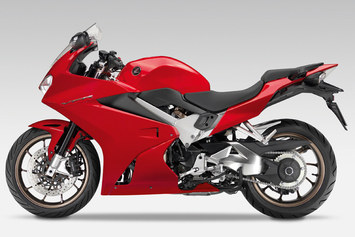
Gen 8 2014-
Sales figures don't lie and even the world's largest powersports manufacturer has to listen. If the 1200 isn't what the market wanted, then it's back to what it did. For 2014 the world would get a remake of the 800 and the result is what Cycle World calls, "...a refined middleweight sport tourer that recaptures the spirit and elegance that helped the original VFR's become legends in their own time."
Those refinements include up-to-date style, unmatched fit & finish, LED lighting, 20 fewer pounds, better suspension, adjustable seat height, narrower girth, a useful selection of optional factory accessories, and a windscreen that actually works. The bane of the previous 800's, abrupt VTEC transition, has been exorcised with revised cams and fuel mapping. Gone are the linked brakes, but there's optional traction control. Two trim levels are offered, with the Deluxe including ABS, traction control, adjustable fork, remote shock preload, self-cancelling turn signals, heated grips and a centerstand, all for $13,500 in your choice of red or white.
Is this the bike Honda should have built back in 2002? Hindsight aside, this VFR is very much a natural evolution, something Honda excels in. The middleweight VFR is back and is better than ever. As Motorcycle Consumer News notes, "Dynamics such as control feel, power delivery and handling are all so perfectly neutral that you have to wonder how other bikes get shipped with all the flaws they possess."
Welcome back.
Sales figures don't lie and even the world's largest powersports manufacturer has to listen. If the 1200 isn't what the market wanted, then it's back to what it did. For 2014 the world would get a remake of the 800 and the result is what Cycle World calls, "...a refined middleweight sport tourer that recaptures the spirit and elegance that helped the original VFR's become legends in their own time."
Those refinements include up-to-date style, unmatched fit & finish, LED lighting, 20 fewer pounds, better suspension, adjustable seat height, narrower girth, a useful selection of optional factory accessories, and a windscreen that actually works. The bane of the previous 800's, abrupt VTEC transition, has been exorcised with revised cams and fuel mapping. Gone are the linked brakes, but there's optional traction control. Two trim levels are offered, with the Deluxe including ABS, traction control, adjustable fork, remote shock preload, self-cancelling turn signals, heated grips and a centerstand, all for $13,500 in your choice of red or white.
Is this the bike Honda should have built back in 2002? Hindsight aside, this VFR is very much a natural evolution, something Honda excels in. The middleweight VFR is back and is better than ever. As Motorcycle Consumer News notes, "Dynamics such as control feel, power delivery and handling are all so perfectly neutral that you have to wonder how other bikes get shipped with all the flaws they possess."
Welcome back.
Sources
Honda's V-Force by Julian Ryder
Honda VF and VFR Interceptor by Clement Salvadori
Honda M/C Identification Guide
Wikipedia
Cycle World
Motorcycle Consumer News
Motorcyclist
V-Source.org
hondavfr.org
https://youtu.be/tt4iXRcwHeY (A Video History Of The Honda VFR)
Forum Links
http://www.vfrdiscussion.com/
http://vfrworld.com
Honda's V-Force by Julian Ryder
Honda VF and VFR Interceptor by Clement Salvadori
Honda M/C Identification Guide
Wikipedia
Cycle World
Motorcycle Consumer News
Motorcyclist
V-Source.org
hondavfr.org
https://youtu.be/tt4iXRcwHeY (A Video History Of The Honda VFR)
Forum Links
http://www.vfrdiscussion.com/
http://vfrworld.com